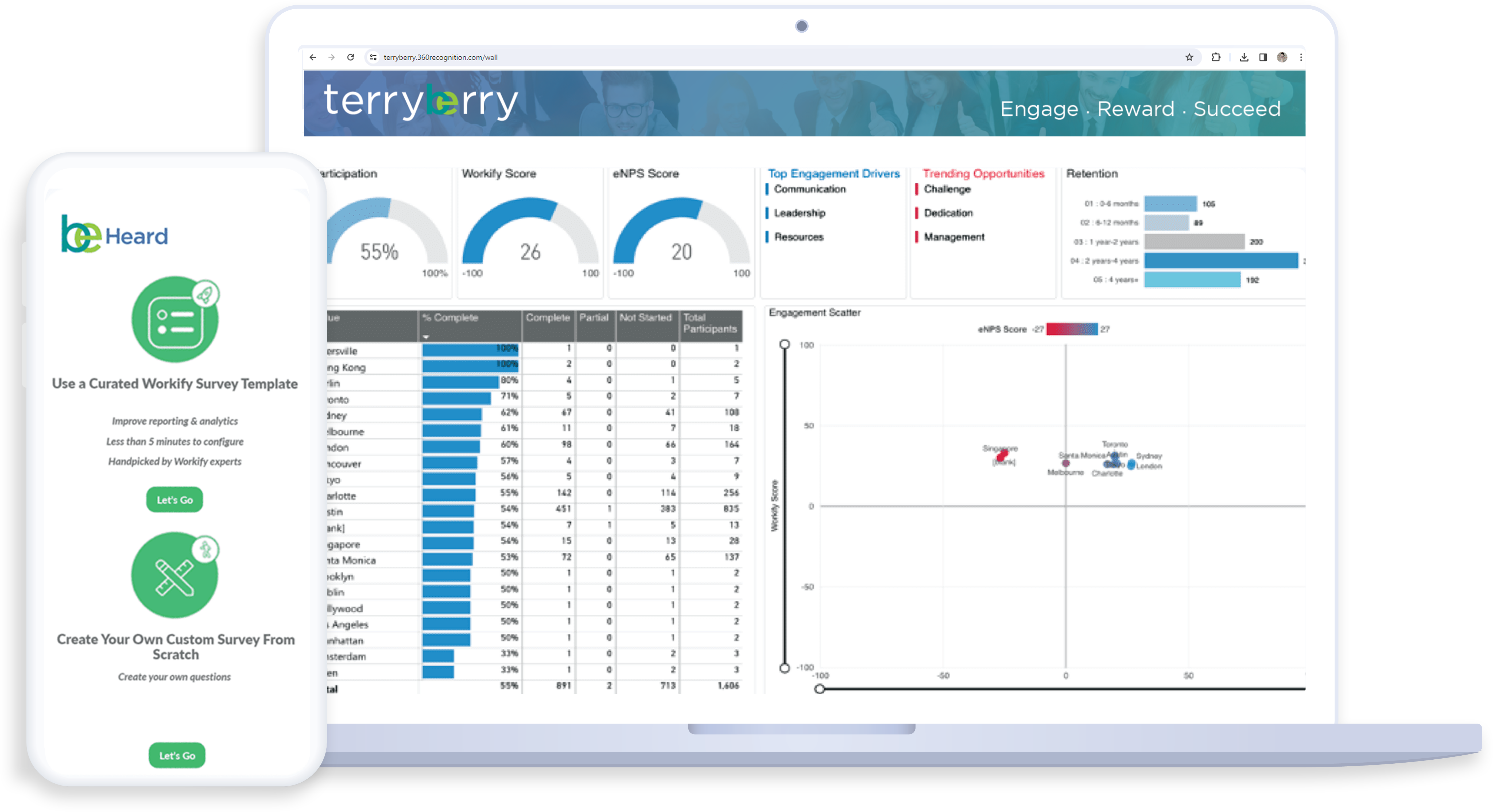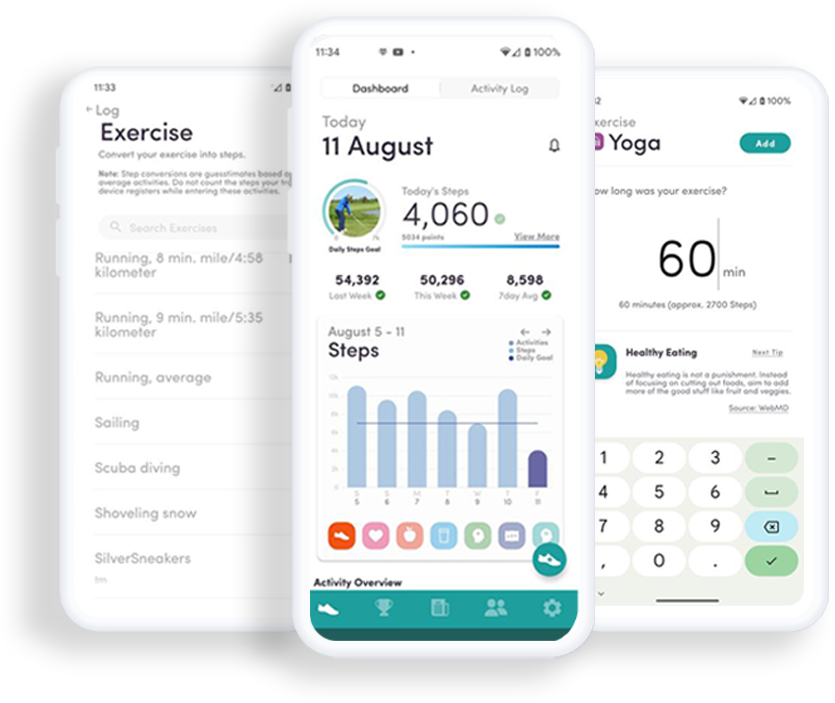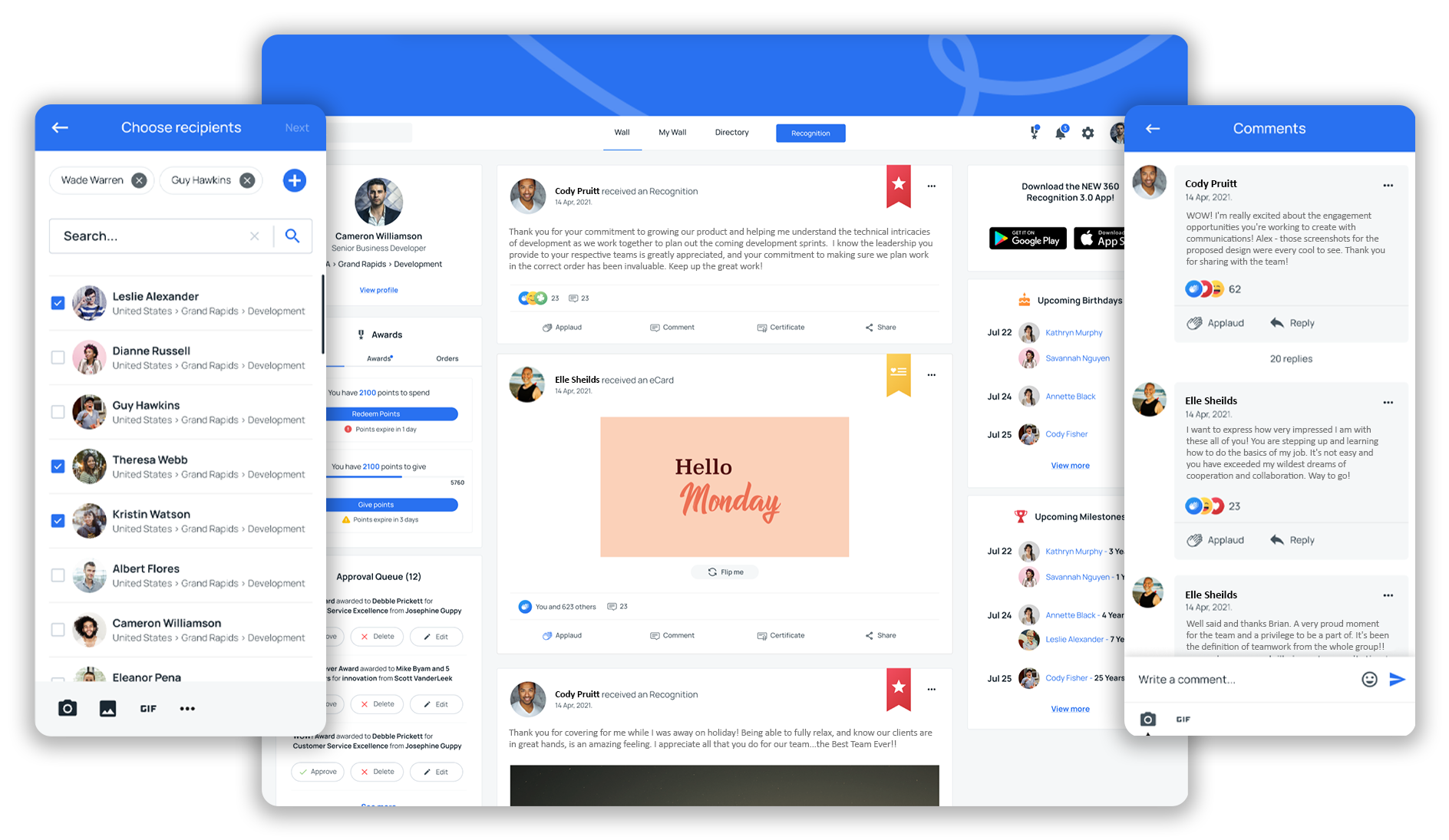April 1, 2024


Employee engagement is one of the most important aspects of human resources today. While it wasn’t always so emphasized, now we have stacks of research that support just how important having highly engaged employees really is to an organization.
From decreased employee turnover and lower absenteeism in the workplace to increased morale and higher productivity, engaged employees truly are the key to a successful, resilient company.
The issue, however, isn’t with understanding its importance. The issue is finding the right strategies to engage and motivate employees in the first place. It’s being able to look past the ping pong tables and pizza parties and figure out how to build employee engagement that actually moves the needle.
Here, we’ll discuss a few employee engagement strategies that every manager or leader can use to start building a fully engaged workforce.
What is Employee Engagement?
First, let’s establish what employee engagement is.
Employee engagement refers to the emotional commitment, involvement, and enthusiasm employees have toward their workplace and work culture. It’s more than just numbers, and bottom lines. It’s about the personal connection employees feel with their jobs, colleagues, and the organization as a whole.
While employees may be satisfied with their work, employee engagement asks how involved they are. How open are they to potential outside opportunities? How do they feel when they begin work each morning?
While a bit abstract, there are several factors most people look at when considering employee engagement.
Key elements of employee engagement include:
Effective employee engagement strategies involve creating a positive work environment, fostering open communication, providing opportunities for learning and development, recognizing and rewarding achievements, promoting work-life balance, and encouraging a culture of collaboration and employee feedback.
Commitment:
Engaged employees are committed to the organization's goals and values. They believe in its mission and are dedicated to contributing their best efforts to help achieve objectives.
Motivation:
Employees who are engaged are self-motivated and driven to perform well. They take initiative, and set high standards for themselves, fellow employees, and future employees. They continuously seek ways to improve and grow professionally.
Emotional Connection:
Engaged employees feel a strong emotional connection to their work, colleagues, and the organization as a whole. They derive personal satisfaction from their jobs and find meaning and fulfillment in what they do.
Empowerment:
Engaged employees are empowered to make decisions, voice their opinions, and contribute ideas. They feel valued, trusted, and supported by their leaders and peers.
Recognition and Feedback:
Engaged employees receive regular recognition and constructive feedback for their contributions. This might include milestone awards or service awards, social recognition, public recognition events, or even just a thank you.
Opportunities for Development:
When employees have opportunities for learning, growth, and career development they're more likely to be engaged. This is especially true for younger employees.
According to a LinkedIn study, 40% of young workers said they were willing to accept a 5% pay cut to work in a position that offered career growth opportunities. Additionally, 76% of Gen Zers want more opportunities to move up or increase responsibilities at work.
Organizations that prioritize employee engagement often experience higher productivity, lower turnover rates, increased job satisfaction, and better overall performance.
RELATED: What is an Employee Engagement Survey? And Why Should You Care?


Employee Engagement Today
As mentioned, today most leaders are aware of the benefits of prioritizing employee engagement strategies. In fact, research from Dale Carnegie found that 85% of leaders say improving employee engagement is a priority.
Yet employee engagement in 2022 declined to a mere 32% – down from 36% in 2020 and 34% in 2021. Furthermore, employee disengagement is on the rise, with 18% of employees now reporting being actively disengaged.
So, employee engagement has become a top priority in recent years, yet employee engagement has still decreased - what’s going on?
RELATED: Employee Disengagement: 7 Signs Your Employees are Disengaged (and What to Do About It)
Priority Mismatch
There are likely several factors at play that underpin this discrepancy. However, there’s one factor at the root of it all – a misalignment of priorities between employer and employee.
Harvard Business Review conducted a study and found that leaders are often not aware of what it is that’s most important for driving employee engagement. That is, the factors leaders think are most important do not correspond to what is actually important to their employees.
This mismatch between leaders’ priorities and their employees’ priorities makes it virtually impossible to set up a successful employee engagement strategy. It’s no surprise employee engagement is on the decline – employees aren’t getting what they need.
Other Reasons for Employee Disengagement
A misalignment of priorities may be the root of much disengagement, but there's a wide range of areas where employees and employers can misalign.
Here are some common reasons for employee disengagement:
Poor Leadership:
Ineffective or unsupportive leadership can contribute significantly to employee disengagement. In fact, new research suggests that for almost 70% of people, their manager has more impact on their mental health than their therapist or their doctor—and it’s equal to the impact of their partner.
Lack of Recognition:
Oftentimes, employees who feel that their efforts are not recognized or appreciated become disengaged. Research has found that employees who receive regular recognition are 23% more likely to be engaged at work.
Additionally, when employees believe they’ll be recognized for their work, they’re nearly 3 times more likely to be highly engaged.
Limited Opportunities for Growth:
When employees feel that there are limited opportunities for their career growth, advancement, skill development, or learning within the organization, they're more likely to become disengaged.
A lack of clear career paths or professional development programs can not only lead to frustration but it can leave employees feeling aimless, which is a major factor for disengagement.


Poor Work-Life Balance:
Excessive workload, long hours, unrealistic expectations, and a lack of flexibility can lead to burnout, poor mental health, and disengagement among employees.
However, a flexible work environment has been shown to decrease stress, boost levels of job satisfaction, and help employees maintain healthier habits. A healthy work-life balance is essential for employees to have a positive emotional connection with work and maintain their engagement.
Unclear Expectations:
When employees are unsure about their roles, responsibilities, goals, or performance expectations, they may feel disengaged and demotivated. Clear communication and goal alignment are crucial for keeping employees engaged and focused.
Low Morale:
Negative workplace culture, conflicts among team members, lack of job satisfaction, and unresolved issues can contribute to low employee morale and disengagement. A positive and supportive work environment is essential for fostering employee engagement.
Job Dissatisfaction:
Employees who are dissatisfied with their jobs, tasks, or work environment are more likely to become disengaged. It's essential to address concerns related to job design, workload, autonomy, and job fit to improve employee satisfaction and engagement.
Poor Communication:
A lack of transparent and open communication within the organization can lead to misunderstandings, rumors, and a sense of disconnection among employees. Effective communication channels and practices are crucial for building trust and fostering employee engagement throughout.
Inadequate Resources:
Insufficient resources, tools, training, and support can hinder employees' ability to perform their jobs effectively and contribute to disengagement. Providing necessary resources and investing in employee development can also improve employee engagement levels.
Mismatched Values:
When employees' values, beliefs, or goals are not aligned with those of the organization, they may feel disconnected and disengaged. Ensuring alignment between individual and organizational values can improve engagement and commitment.
By addressing these factors and implementing strategies to enhance leadership, recognition, development opportunities, work-life balance, communication, and organizational culture, companies can mitigate employee disengagement and foster employee engagement and a more productive workforce.


3 Best Employee Engagement Strategies
Of course, knowing there’s a mismatch between leaders’ and employees’ priorities is only part of the solution. The next step is learning what does matter to employees and finding ways to give it to them.
While it’s always a good idea to send an employee engagement survey to your employees to learn what’s most important to the people at your organization, there are three common priorities employees tend to have. And the best part? Every manager has access to them.
They are:
- Connecting what employees do to what they care about
- Making the work itself less stressful and more enjoyable
- And rewarding employees.
Let’s dive in deeper into the best employee engagement strategies and how managers can incorporate these areas into their overall employee engagement strategy.
1. Connect What Employees Do to What They Care About
We live in a time when people are no longer satisfied with having just any job. Some experts blame the pandemic for changing our collective perspectives and the Great Resignation that followed.
Regardless of why it happened, the fact is that somewhere along the way, our values did shift. And today, most people want to feel that their work has meaning. We want to believe we’re not wasting our lives at work.
In fact, a study from McKinsey & Company found that 82% of employees believe it’s important their company has a purpose; ideally, one whose company's core values emphasize contributing to society and creating meaningful work.
And when a company has a purpose, its people do, too. Another study from McKinsey found that 70% of employees say their personal sense of purpose is defined by their work, and when that work feels meaningful, they perform better, are much more committed, and are about half as likely to go looking for a new job.
While you likely won’t be able to adapt each employee’s role to fit all of their passions, you might discover some helpful interests.
For example, one of your accountants might have a passion for fitness and would love to start a walking club and host step challenges at your company. An effective employee engagement strategy would support this employee's inclination to get involved in the company culture.
You also can reiterate how each employee’s role matters to the company’s mission. But don’t speak in broad terms - get specific. Tell customer service that their patience and empathy are what keeps your clients happy. Remind sales that their ability to connect with people is what generates revenue.
Everyone plays an important role, so support your engagement strategy and help keep your current and future employees engaged by telling them.


2. Make Work Less Stressful and More Enjoyable
Making work less stressful for your employees doesn’t just benefit them, it improves your bottom line too. Studies have found that stress makes people nearly three times as likely to leave their jobs, temporarily impairs strategic thinking, and dulls creative abilities.
Most managers, however, don’t intend to create a stressful environment. Burnout cultures tend to develop indirectly if there aren’t conscious efforts in place to prevent it.
Luckily, there are plenty of ways to build an environment that's resistant to stress, boosts satisfaction, and employee engagement.
Here are just a few:
Build a Mistakes Culture:
A study in Psychological Bulletin found that perfectionism is on the rise. And while maintaining high standards can push individuals to achieve a higher level of performance, studies show it comes at a cost.
Research from York St. John University found that perfectionism is linked to burnout, depression, anxiety, and even mortality. If your company fosters perfectionism, combat it with a mistakes culture instead.
A mistakes culture encourages employees to take chances and doesn’t punish people for failure. The idea is to put more emphasis on creativity and innovation rather than success. Fortunately, when people aren’t afraid to fail, they tend to succeed at a much higher rate.
Define Working Hours:
It’s crucial for the success of your employee engagement strategy that employees know they’re not expected to be “always on.” In today’s digital world, it’s all too easy for people to be always available. This has ended up blurring the lines between work time and time off.
So, make it a point to not contact employees after hours - scheduling emails can be a great way to work on your own schedule without imposing unintended expectations on your team. Also, encourage employees on your team to use their PTO, and be sure your employees are taking regular breaks.
And if you think an employee is always on, check in with them and make sure their workload is manageable. This is one where leading by example can go a long way.
Empower with Autonomy:
No one likes to be micromanaged and nothing instills a sense of distrust faster. Conversely, allowing your team to work autonomously fosters trust, independence, and growth.
Research from Forbes about self-determination theory suggests that autonomy is a key component of employee motivation. When employees feel they have control over their work, they're more likely to be satisfied, fulfilled, and engaged.
In fact, a study by Gallup found that employees are 43% less likely to experience high levels of burnout when they have a choice in deciding what tasks to do, when to do them, and how much time to spend on each.
Listen to Employees
It can be difficult to maintain a steady pulse in your work environment without intentionally trying to do so. That's where an employee engagement survey strategy can be helpful.
Having an employee engagement or pulse survey strategy will help managers and leaders understand what's most important to their employees. These surveys can help gauge sentiment and engagement, as well as shed light on potential issues within the company.
Not only will this employee feedback benefit the company as a whole, it shows employees that their voice matters to leadership - and it's much easier to be actively engaged in an organization when you feel a part of its success.


Develop a Wellness Program:
As much as we may want work to be stress-free, it’s not a realistic goal. Life is full of stress - the key is finding healthy ways to process it. Wellness programs can be a great tool for teaching strategies for dealing with stress.
Consider setting up a corporate wellness program as a part of your employee engagement strategies, like Terryberry's Be Well platform, which touches on physical and mental wellness. Offer employees activity challenges as well as tips for managing stress and resources for seeking mental health help.
While beneficial, a corporate wellness program won’t be a panacea for a toxic work culture. Companies should support employees in all areas of their lives, from physical fitness to mental wellness to financial stability. Learn how Terryberry's corporate wellness program can play a role in your employee engagement strategy.


3. Create a Culture of Recognition
Employee recognition programs have been gaining popularity in recent years due to their ties to increased employee retention, engagement, and productivity. It may seem hard to believe that simply recognizing employees can generate all these returns, but it’s true.
In fact, research shows that when employees believe they’ll be recognized for their work, they’re nearly 3 times more likely to be highly engaged. Employee engagement, productivity, and customer service are about 14% higher where recognition occurs. And companies with effective recognition programs have 31% lower voluntary turnover.
So, how can leaders incorporate recognition into their engagement strategies? Here are a few ways.
Giving employees extra time:
Research shows that working hours for college graduates have been steadily increasing over the past 30 years. This has left many employees feeling as though they have little to no free time. So, being able to offer employees extra time will typically be appreciated.
This is one reason why remote and hybrid work is so valued by workers today - time saved on commutes, getting "ready" in the morning, meal prepping lunches on the weekends all take up people's personal time. And employees are keenly aware of that.
So much so, a report from Forbes found that 59% of respondents feel that “flexibility” is more important to them than salary or other benefits, and 77% said they would prefer to work for a company that gives them the flexibility to work from anywhere rather than fancy corporate headquarters.
But even when flexible work schedules can't happen, there are still things you can do. Whether it’s awarding extra PTO, hosting non-work-related outings, or providing time-saving perks (like discounts for housecleaners or food delivery services), when people have time to invest in their own interests, they become better employees.
RELATED: The 4-Day Work Week: What Is It and Why It’s Gaining Popularity
Publicly recognize employees:
Consider adding a moment to team and/or company meetings to give individuals public recognition or a shout-out for a job well done. It’s a simple gesture but it can carry significant weight.
That’s because when an employee’s hard work is acknowledged and appreciated, it creates a dopamine surge in the brain. Dopamine is powerful and motivating, and, most importantly for managers, reinforces the behavior.
One study even found that receiving a compliment, like genuine recognition, is just as thrilling to the brain as receiving cash— both are perceived by the striatum as "social rewards."
That dopamine hit cements the knowledge that more of that behavior will create more praise, resulting in another dopamine surge, and so on. This is why positive reinforcement (recognition) benefits both employees and managers.
Giving employees a monetary bonus:
While monetary recognition can be very effective, it’s also impersonal. So, it's important to know that this shouldn't be the basis of your employee engagement strategies. In fact, money should never be the only form of recognition you give your employees.
Too much focus on monetary rewards can also create a toxic environment, which is often counter-productive. It’s important to find a balance that works for your company culture.
Implementing a social recognition platform:
If you have an employee recognition budget in place, consider adding a recognition program to your employee engagement strategy. There are all kinds of programs available to help build recognition into your company’s culture.
The Terryberry Be Recognized Platform offers a comprehensive solution that can host your recognition efforts, including milestone and service awards, peer-to-peer social recognition, feedback and communication, and performance and incentive rewards.
This platform even allows for analytics that show real-time key employee performance indicators so you can be sure your program is effective. This is a great way to help engage employees by creating a culture of recognition by empowering employees (as well as leaders) to recognize each other.


Benefits of Employee Engagement Strategies
As we know, strong employee engagement offers numerous benefits to both employees and organizations. Some of the key benefits of effective employee engagement strategies include:
Increased Productivity
Engaged employees are more focused, motivated, and committed to their work. They are willing to invest discretionary effort to achieve goals, which leads to higher productivity levels and improved performance.
So much so, research from Gallup found that companies with higher employee engagement experienced a 21% boost in productivity compared to those with lower employee engagement levels.
Better Employee Retention
Engaged employees are less likely to leave the organization compared to disengaged employees. They feel connected to their roles, colleagues, and the company's mission, leading to lower turnover rates and reduced recruitment and training costs.
Improved Morale
Engaged employees naturally have a positive attitude towards their work and the organization. They experience higher job satisfaction, a sense of fulfillment, and overall well-being, and bring a positive presence to the team.
Enhanced Innovation and Creativity
Engaged employees are more likely to generate new ideas, solutions, and innovations. They feel empowered to share their opinions, collaborate with colleagues, and contribute to continuous improvement initiatives, leading to increased creativity and innovation within the organization.
Better Customer Satisfaction
Engaged employees are more attentive to customer needs, provide better service, and build stronger relationships with clients. Satisfied customers lead to increased customer loyalty, repeat business, and positive word-of-mouth referrals, benefiting the organization's reputation and bottom line.
Higher Employee Advocacy
Engaged employees are enthusiastic about their work and the organization. They are more likely to promote the company's products, services, and values to others, acting as brand ambassadors and contributing to positive employer branding.
Reduced Absenteeism
Engaged employees are more likely to show up for work regularly and have lower rates of absenteeism. They are motivated to contribute, meet deadlines, and fulfill responsibilities, leading to a more reliable and consistent workforce.


Positive Company Culture
Strong employee engagement fosters a positive organizational culture characterized by trust, collaboration, transparency, and open communication. This culture attracts top talent, improves employee morale, and strengthens teamwork and cohesion.
Higher Profitability
Engaged employees positively impact the organization's financial performance. Their increased productivity, lower turnover costs, improved customer satisfaction, and innovative contributions lead to higher profitability and sustainable growth.
Continuous Improvement
Engaged employees are committed to ongoing learning, development, and performance improvement. They seek feedback, embrace challenges, and strive for excellence, contributing to a culture of continuous improvement and organizational success.
Overall, employee engagement strategies create a win-win situation where employees experience greater satisfaction and fulfillment, while organizations benefit from increased productivity, reduced turnover, improved customer satisfaction, and a positive work culture.
Start Building an Engaged Team Today
Overall, strong employee engagement creates a win-win situation where employees experience greater job satisfaction and fulfillment, while organizations benefit from increased productivity, reduced turnover, improved customer satisfaction, and a positive workplace culture.
Building effective employee engagement strategies won’t happen overnight. It will take time and consistent effort for these tactics to come to fruition. And if you’re looking for guidance along the way, Terryberry can help.
Terryberry provides solutions to help drive performance and retention through effective employee engagement. These solutions include:
- Service Awards and Performance Awards: Recognize and reward employees based on years of service awards, anniversaries, or performance.
- Social Recognition: Empower your employees and managers to recognize their peers and celebrate successes with an easy-to-use social recognition application.
- Feedback and Communication: Unlock improved feedback and communications with employee and customer feedback solutions.
- Wellness Programs: We make it easy to run wellness programs and activity challenges that increase engagement, expand corporate health, and build team camaraderie.
Ready to learn more? Schedule a demo with our team to get a hands-on walkthrough of how Terryberry can transform the culture of your workplace


